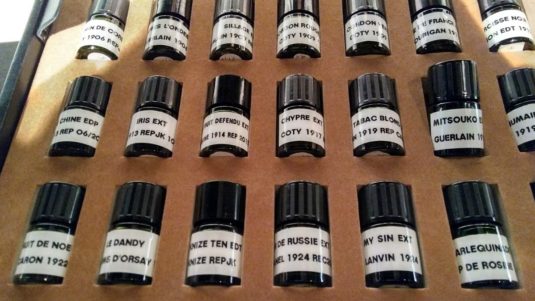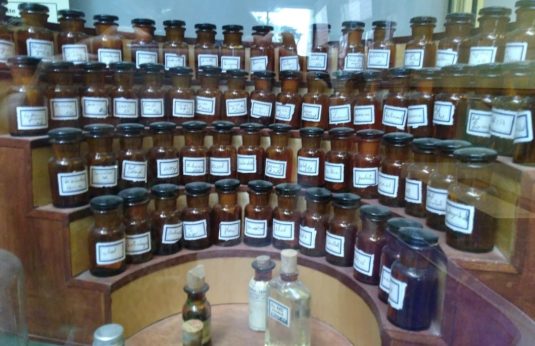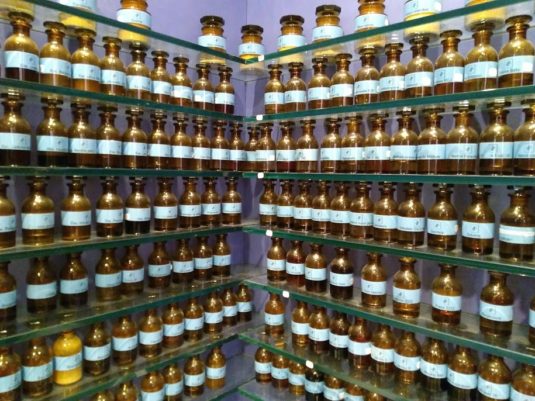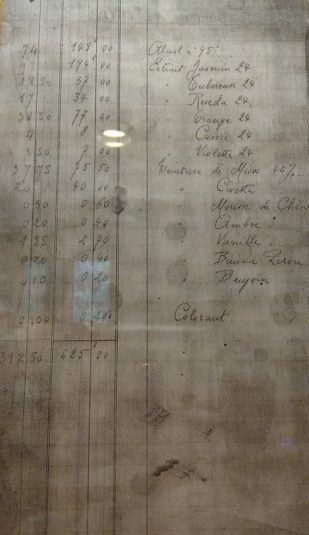
Osmothèque perfume treasures at Esxence 2018
4,000 perfumes, each with its vintage and olfactory appellation, wait to tell their histories on matter-of-fact shelves. Stored like wine in darkened, temperature-controlled caves, and protected by argon gas, these fragrances – once worn by ladies of fashion, housewives, businessmen, emperors and queens – glint matter-of-factly in their cased amber bottles, as neatly numbered and colour-coded as in a medical lab. But take a bottle of the original Narcisse Noir from 1911, and inhale it dangerous dark beauty, or catch a whiff of soapy green perfection that is Coty Chypre, smelling as if it had been mixed the day before instead of in 1917, or savor an exact recreation of history’s first known perfume, recorded by Pliny the Elder in the 1st century AD, and you have left the lab and tumbled headfirst into Wonderland.

Jean Kerléo
Founded by former Patou perfumer Jean Kerléo in 1990, Osmothèque is the world’s first archive of fragrance; sampling, testing, categorizing, notating and carefully storing our olfactory history. Osmothèque chronicles the evolution of fragrance and the development of fragrance families and subgroups, and, most importantly, houses the original recipes for many of the greatest perfumes ever made. It stores roughly 400 discontinued perfumes – perfumes of near mythic status such as the original Jacques Fath Iris Gris from 1946 (Vincent Roubert) and Lanvin Scandal from 1931 (André Fraysse), original Carons, Patous, Lubins, Chanels, Rosines and Diors alongside perfumes from long-forgotten houses. Kerléo spent years tracing the descendants of brands that no longer exist to track down discontinued perfumes and preserve their compositions, and many of these are now tucked away in a vault in Versailles along with some other 200 recipes. In addition to being a repository of perfumes past, Osmothèque is also a living collection, adding fragrances that its panel of experts determines worthy of preservation. These now include fragrances from independent brands: scents from Francis Kurkdjian and Parfum d’Empire have both made their way into Osmothèque’s annals.

Osmothèque keeps not only fragrances but many of the rare raw ingredients that made them what they were. Quite a few of these materials are no longer available today due to chemical bans and endangered sources, so having this living record is invaluable as a way of understanding and experiencing the development of perfumery. Touring Osmothèque with its fantastically knowledgeable president, Master Perfumer Patricia de Nicolai, I am introduced to a musk from the 1950s. It takes a few moments to open, but then, wallop! It’s as if I am standing in the monkey house at the zoo. Smelling the gamey, almost decayed fruitiness of the original ingredient, I can better grasp how it provided the basis some of the great animalics such as Rochas Femme (1944; Edmond Roudnitska) and Schiaparelli Shocking (1937; Jean Carles).

Patricia de Nicolai, perfumer and President of the Osmothèque
Then the moment I have been craving comes: Mme. de Nicolai asks me what I would like to smell, and my eyes nearly glaze over. How to choose among these hundreds of rare gems? Overcome and unprepared, I select, perhaps predictably, Hermes Doblis (1956; Guy Robert), which I have encountered before and even possess a small amount of. But my carefully stored vial cannot compare with the herbal-floral-fine glove leather fragrances that emanates from Osmothèque’s bottle. We lament that Hermes does not see fit to bring back Doblis permanently, given the vogue for leather perfumes and Doblis’ elegant, modern beauty. My next choice is rather more obscure: La Belle de Bois Dormant (1934; Raymond Kling) by Houbigant. I own a very damaged miniature of this and was shocked when I smelled the perfectly preserved Osmothèque version: an oriental citrus, bright and full-bodied, as potent and multilayered as a 2018 launch and nothing like my little flask. My final choice is Djedi by Guerlain, of which, again, I possess a small amount. Mme. de Nicolai looks at the chart that shows the state of the perfume when it was initially stored and frowns, warning me the top notes are damaged. But even with that caveat, as the bottle opens, an enveloping swirl of jade green, animal chypre exhales like sultry genii. I am left bewildered by the safe prettiness of some of Guerlain’s recent scents when that great house could be producing … this.

Synthetic ingredients for perfumes
Mme. De Nicolai has been working to create ambassadors within the perfume houses that create the scents for the brands – Firmenich, Givaudan, Robertet, Mane, etc. – to ensure that current formulations are stored with Osmothèque for prosperity. As the day winds down, she says “Perfume is an art … We need people to understand the importance of perfumery; new perfumers need to smell the older perfumes.” Fragrance, like all art, is informed by what has come before it. Whether the olfactory past is embraced, rejected or turned on its head by new perfumers, it is the touchstone from which they create. We cannot hear Mozart composing, nor watch as Rembrandt brushed chiaroscuro onto canvas. But, thanks to Osmothèque, glimmers of our history are here, now, for us to know and rejoice in through living scent. We can smell what Napoleon wore; what the first Guerlain Mitsouko smelled like, with its exquisite peach note, as if we were there on the day they were bottled. What a poignant, beautiful gift.

An old perfume formula
Note: Osmothèque is a non-profit offering talks and workshops on perfumery regularly throughout the year, occasional special events, and a specialized bookstore crammed with fascinating explorations of perfumery and its history. But its team is tiny – 4 people make up its full-time staff, and the rest of Osmothèque’s day-to-day functioning depends on volunteers. Becoming a member of the Societé des Amis de l’Osmothèque (SAO) helps maintain the center’s essential work while offering a number of perks, such as discounted sessions, cultural outings and free entrance to SAO talks. Supporting Osmothèque is more than simply a charitable contribution: For those who dream of smelling Iris Gris, Doblis, Djedi or the thousands of other jewels in this matchless collection, it is buying a ticket to history.
–Lauryn Beer, Senior Editor
All photos by Lauryn with the exception of Jean Kerléo, which is courtesy of Osmothèque.
A special thanks to Patricia de Nicolai and Anne-Cecile Pouant for being such lovely and generous hosts.
The Osmothèque is located 36 Rue du Parc de Clagny, 78000 Versailles, France
What rare perfume treasure at the Osmothèque would you love to own or do you already own. What modern era perfumes would you like to see stored at the Osmothèque?
